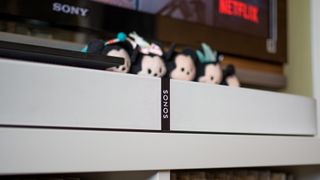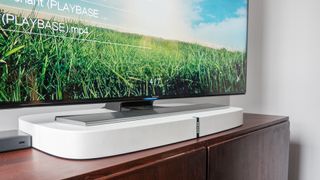TechRadar Verdict
The Sonos Playbase continues the company’s philosophy of making easy-to-use and good-sounding speakers in an attractive package. But, due to the lack of support for many surround sound formats, artificial sounding processing and ecosystem lock-in, cinephiles will want to look elsewhere.
Pros
- +
Excellent sound quality
- +
Apartment-shaking bass
- +
Works flawlessly with other Sonos products
- +
Easy to set up and use
Cons
- -
Optical-only connection
- -
Virtual surround sounds artificial
- -
TruePlay calibration for iOS only
- -
Expensive
Why you can trust TechRadar
Update: Sonos Playbase now has AirPlay 2 functionality. To get AirPlay 2 up and running, download the latest version of the Sonos app on your iPhone or iPad, then run the firmware update for your Sonos Playbase. After that, swipe up from the bottom of the screen and select the music playback section. In it, you'll find the Playbase.
Original review continues below...
Three years after the company released its first ever soundbar, the Playbar, Sonos has created the Playbase, a unique form factor sound system that combines a stable pedestal for your TV with an audio cabinet.
Why did Sonos create a second home entertainment device? The team did extensive research into how people used their Playbar at home and found that most people didn’t wall-mount their televisions or Playbars. To that end, the Playbase was created to allow people to set their televisions right on top of the speaker, allowing for a compact home theater solution.
Coming in at $699 (£699, AU$999), the Playbase isn't cheap, but in return for your financial investment you’ll get a compact and flexible audio solution that integrates seamlessly with other Sonos speakers in your home.
So, how do they stack up? Let’s have a listen and see how they compare.

Design
The PlayBase is one of the nicer looking pieces of equipment that Sonos has produced. From the clean matte finish to the subtle touch controls on its front, the whole speaker has an understated design that helps it blend into a home theater. This created a conundrum for Sonos as they had to create a soundbase that was pretty yet didn’t grab too much attention.
In order to keep the looks as subtle as possible, Sonos worked to design just the right amount of speaker holes (over 43,000) that optimized performance but also obscured its 10 internal drivers from being a visual distraction.
The Playbase comes in a flat white or black and while both blend into most home theater setups we prefer the black finish because of how it matches most televisions, and the white PlayBase we had for review also started to gather dust and dirt surprisingly quickly. The Playbase measures in at 2.28 x 28.35 x 14.96 in. (58 x 720 x 380 mm), making it quite thin for a playbase, helping the speaker blend in perfectly on our Ikea bookshelf-turned-TV-stand.

The top of the speaker houses three buttons for play and pause, music playback control and volume. The play/pause button features a small light that flashes different colors to indicate speaker status. Buttons to the left and right of the play/pause button control volume and users can swipe left and right across the buttons to skip or rewind tracks. The only other button is the sync button used during the setup process.
Around back, the port options are extremely simple: one Ethernet, one optical and one power. That’s it. Sonos’ philosophy is to create products that are easy to use and it's hard to argue with simplifying port selection ... that is until you realize the Sonos Playbase has a horrifyingly large Achilles Heel (more on that in the Performance section).
Curious if your TV will fit on top of the Sonos Playbase? Sonos claims the speaker can withstand 75 lbs (about 34 kg) so you’ll want to check the specs on your TV to see if it falls under that weight. Also, if you want to slide the Playbase underneath your TV instead of placing a TV on top, you’ll also want to measure your TV’s feet to see if the Playbase can comfortably fit underneath it, too.
Worst-case scenario, if it doesn't fit, there’s always the Sonos Playbar instead.

Sonos wants all of its products to be simple and easy to use and, for the most part, it succeeds with the Playbase. The included quick start guide gives users a visual representation of how to hook up the speaker. Simply take the included optical cable and connect the Playbase to the optical output on your TV. Then take the power cable and plug it into the wall. If you have a router near your home theater, you can opt to wire in with the included Ethernet cable.
The final step is to download the Sonos app for Android or iOS to complete the installation. The Sonos app guides you through the rest of the setup so the Playbase can hop on your network.
Now, you should note that the Playbase only supports the 2.4GHz band so don’t be worried if you can’t find your 5GHz network. Sonos did this deliberately for a more reliable connection with better range.
It’s also worth pointing out that although optical audio out ports are common on more modern TVs, one of our reviewers found that their TV wasn’t equipped with one, which made hooking up the PlayBase more complicated than it needed to be. There are ways around this (like running the soundbase through your cable box or receiver) but setup can be tricky.

After your Playbase is connected to your home network, you can start playing music by adding the 80+ music services to the app. The Sonos app picked up our Google Play Music, Plex and Soundcloud accounts without issue, giving us access to universal search across music platforms from the Sonos app.
It’s also worth mentioning that, thanks to a recent update, all of Sonos’s lineup is now Spotify Connect enabled. Select the Playbase from the Spotify app, and you can control both track playback and volume from within the same piece of software. It’s easy and intuitive, and we found ourselves relying on it far more than Sonos’s own software.
For iOS users looking to squeeze every last drop of performance out of the Playbase, there’s the Trueplay calibration located in the settings of the app.This calibration detects objects in your room to help bounce sound off of to create a more immersive virtual surround system. The whole process takes about a minute but we ran into an issue where Trueplay calibration would fail. After speaking with Sonos support, we were instructed to remove any cases from our iPad, after which Trueplay worked like a charm.
Unfortunately for Android users, Trueplay is only available for iOS users and it doesn’t seem like Sonos is going to bring the feature to Android devices any time soon. Sonos says there are just too many types of microphones on Android phones to make Trueplay calibration work across so many devices. Bummer.
Performance
None this would matter if the Playbase didn’t sound good but we’re happy to report that it does in fact sound quite good. Even without Trueplay calibration, the Playbase offered punchy bass, crisp vocals and a good sense of soundstage depth and height.
Watching Revenge of the Sith’s opening space battle, for example, created a fantastic sense of explosions and detritus flying to our left and our right, along with the satisfyingly low rumble of Star Destroyers in the distance. For most users, we feel the bass quality and quantity is good enough from the Playbase itself. Watching Casino Royale, explosions and foot steps sounded much more realistic and visceral than playing off the TV’s speakers.
The bass was enough to rattle the entire room, which is something that can’t be said of most soundbars that don’t have an external subwoofer. If you live in a flat or like to do your movie watching late at night then you have to be careful with the PlayBase’s volume levels. Should you decide you want even more bass, though, Sonos offers a subwoofer add-on for an additional $699 (£699, AU$999), which adds even more visceral impact and will definitely upset the neighbors.

Music sounded excellent from the Playbase at any volume. The Playbase gets shockingly loud and should have no problems filling any room. Likewise, movies good but don’t expect a surround sound experience from the Playbase. Even with Trueplay calibration enabled, the Playbase sounded confined compared to true surround sound systems.
However, there’s good stereo separation which can be heard during scenes with cars moving across the screen, but the Playbase is unable to capture the behind-the-head sound that a true surround sound is capable of. As a result, the sound processing to get faux surround is a bit artificial with sounds being projected wider but not necessarily around your head.

However, the Playbase has the ability to sync with additional Sonos speakers (like the Play:1 and Play:3) to create a true surround sound setup.
It’s a neat feature but it can get pretty pricey as Sonos’ cheapest speakers, the Play:1, cost $199 (£169, AU$299) each. A Playbase and two Play:1 speakers will run you $1100 (£1,037, AU$1597) before you even think about adding the $699 Sonos Sub (£699, AU$999).
More problematic than the surround is the fact that the Playbase features an optical-only connection. This means the Playbase only supports Dolby Digital 5.1 and stereo PCM. We had trouble getting Netflix and Amazon to play its 5.1 audio tracks using our Nvidia Shield. It wasn’t until we switched over to using an Xbox One that we were able to get the Dolby Digital 5.1 audio track to play. The Xbox One was able to transcode Dolby Digital Plus and DTS to Dolby Digital on the fly unlike the Nvidia Shield TV. You’ll also have to check if your TV is capable of bypassing a Dolby Digital signal to the Playbase, which not all TVs do.
For a system that was designed to be easy to use, it sure took a lot of thinking, tinkering and visiting the Sonos support forums to get a Dolby Digital 5.1 signal.

Final verdict
The Sonos Playbase is a good-sounding speaker for those who don’t want to fumble with a true surround sound system or simply don’t have the room for one. There’s no need for a receiver, making it truly plug-and-play. Sonos’ philosophy of making music enjoyment as frictionless as possible continues with the Playbase – the Sonos app is easy to use and the integrated universal search across music services is something we wished every speaker had.
But when it comes to watching movies, the Playbase leaves something to be desired. Its optical-only connection limits you to Dolby Digital 5.1 and good luck trying to get your various sources to output that format. You can theoretically hook up the Playbase to a receiver to transcode Dolby Digital to the speaker but that’s not what the Playbase is designed for.
Overall we enjoyed our time with the Sonos Playbar and ended up liking it a lot. It made playing music so simple that we wanted to have music playing at home all the time. It might not sound as good as the Focal Dimension soundbar and sub, but the Playbase is half the price.
The bottom line? If you don’t mind the fact that most of your listening will be in stereo, the Playbase is a great option to improve your music listening and movie watching experience.
Jon Porter contributed to this review.
- What are the best soundbars for home audio?


